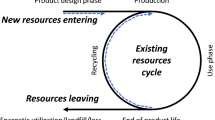Abstract
Purpose
Many companies around the world have been challenged to make their products in a more sustainable way in the last decade in order to minimize their environmental impacts. Klabin, the largest producer, exporter, and recycler of paper in Brazil, has made great efforts to exchange old for new and more efficient equipment to produce cellulose packaging materials. The objective of this study was to measure the benefits of modernization of its plant located in the southern region of the country for manufacturing carrier board/folding box board (CB/FBB) and kraftliner paper (KP).
Methods
The goal established was analyzed through a cradle-to-gate life cycle assessment methodology.
Results and discussion
The modernization carried out has led to several improvements such as the reductions measured by the functional units of 1,000 kg of CB/FBB and 1,000 kg of KP, respectively, of energy consumption (21 and 3 %), water (8.5 % for CB/FBB only), wood (6.6 and 7.2 %), and land use (6.9 and 7.1 %). The environmental impact categories (according to CML 2001) that have suffered greater reductions are human toxicity (68 and 69 %), abiotic depletion (59 and 28 %), and global warming potential (51 and 9 %) for the same reference units.
Conclusions
The results achieved clearly show the importance of renewing industrial plant in order to achieve better environmental performance and also provide a historical inventory perspective for the company to establish future targets for improvement.








Similar content being viewed by others
References
AF&PA-American Forest & Paper Association (2012) Sustainability report. AF&PA, Washington
BSI-British Standards Institution (2011) PAS2050: specification for the assessment of the life cycle greenhouse gas emissions of goods and services. BSI, London
CEPI-Confederation of European Paper Industries (2011) Sustainability report 2011. CEPI, Brussels
Coltro L, Castilho G, Garcia EEC (2003) Life cycle inventory for electric energy system in Brazil. Int J Life Cycle Assess 8:290–296
Cui Z, Yannan H, Hong J, Ismail ZZ (2011) Life cycle assessment of coated white board: a case study in China. J Clean Pro 19:1506–1512
Datamark–Market Intelligence Brazil (2011) Materiais por valor. http://www.datamark.com.br. Accessed 31 May 31 2013
ENVIRON International Corporation (2012) Life cycle assessment of deinked and virgin pulp. http://images.nationalgeographic.com. Accessed 30 May 2013
European Comission (2013) Best available techniques (BAT) reference document for the production of pulp, paper and board, Joint Researcher Centre, IPPC Bureau (of the Commission’s Joint Research Centre) Final draft July 2013
FEFCO-European Federation of Corrugated Board Manufacturers (2010) In the past 3 years, the corrugated board sector reduced its carbon footprint by 11.7 %. 2010. http://www.fefco.org. Accessed 30 May 30 2013
Francis DW, Towers MT, Browne TC (2002) Energy cost reduction in the pulp and paper industry –an energy benchmarking perspective. Paprican-Pulp and Paper Research Institute of Canada, Montreal
Goedkoop M, Spriensma R (2001) The eco-indicator 99-a damage oriented method for life cycle impact assessment. Methodology report. Third edition 22-6-2001. PRé Consultants B.V., Amersfoort, The Netherlands
Guinée JB, Gorrée M, Heijungs R, Huppes G, Kleijn R, Koning A, van Oers L, Wegener Sleeswijk A, Suh S, Udo de Haes HA, Bruijn H de, Duin R van, Huijbregts MAJ (2002) Handbook on life cycle assessment. Operational guide to the ISO standards. I: LCA in perspective. IIa: guide. IIb: operational annex. III: scientific background. Kluwer Academic Publishers, Dordrecht
International Organization for Standardization (2006a) ISO 14040: environmental management–life cycle assessment–principles and framework. ISO, Geneve
International Organization for Standardization (2006b) ISO 14044: environmental management—life cycle assessment—requirements and guidelines. ISO, Geneve
IPCC-Intergovernmental Panel on Climate Change. Climate Change-Synthesis Report (2007) Contribution of working groups I, II and III to the fourth assessment report of the intergovernmental panel on climate change. IPCC, Geneve
Lopes E, Dias A, Arroja L, Capela I, Pereira F (2003) Application of life cycle assessment to the Portuguese pulp and paper industry. J Clean Prod 11:51–59
Manda BMK, Blok K, Patel MK (2012) Innovations in papermaking: an LCA of printing and writing paper from conventional and high yield pulp. Sci Total Environ 439:307–320
Mourad AL, Silva HL, Nogueira JCB (2012) Carton for beverage: a decade of process efficiency improvements enhancing its environmental profile. Int J Life Cycle Assess 17:176–183
Pro Carton-Association of European Cartonboard and Carton Manufacturers (2012) Types of cartonboard. Pro Carton. http://www.procarton.com, Accessed 31 May 31 2013
Pro Carton-Association of European Cartonboard and Carton Manufacturers (2013) Cartonboard packaging: a resource and carbon efficient packaging solution. Pro Carton. http://www.procarton.com, Accessed 31 May 31 2013
Acknowledgments
The authors are grateful to Klabin S/A for providing data and valuable discussions for this work. Authors are also grateful for financial support of this company and to Fapesp who financed the first LCA study for CETEA in 1998.
Author information
Authors and Affiliations
Corresponding author
Additional information
Responsible editor: Zbigniew Stanislaw Klos
Rights and permissions
About this article
Cite this article
Mourad, A.L., da Silva, H.L.G. & Nogueira, J.C.B. Life cycle assessment of cellulose packaging materials production: folding box board and kraftliner paper. Int J Life Cycle Assess 19, 968–976 (2014). https://doi.org/10.1007/s11367-013-0690-1
Received:
Accepted:
Published:
Issue Date:
DOI: https://doi.org/10.1007/s11367-013-0690-1




